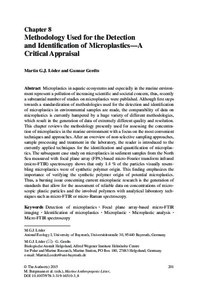| dc.contributor.author | Löder, Martin G.J. | |
| dc.contributor.author | Gerdts, Gunnar | |
| dc.date.accessioned | 2019-12-15T22:14:26Z | |
| dc.date.available | 2019-12-15T22:14:26Z | |
| dc.date.issued | 2015 | |
| dc.identifier.citation | Löder, M.G.L. and Gerdts, G. (2015) Methodology Used for the Detection and Identification of Microplastics—A Critical Appraisal. In: Marine Anthropogenic Litter (eds. Bargeman, M., Gutow, G. and Klages, M.). Heidelbderg, Germany, Springer Open, pp.201-227. DOI:0.1007/978-3-319-16510-3_8 | en_US |
| dc.identifier.uri | http://hdl.handle.net/11329/1180 | |
| dc.identifier.uri | http://dx.doi.org/10.25607/OBP-698 | |
| dc.description.abstract | Microplastics in aquatic ecosystems and especially in the marine environment
represent a pollution of increasing scientific and societal concern, thus, recently
a substantial number of studies on microplastics were published. Although first steps
towards a standardization of methodologies used for the detection and identification
of microplastics in environmental samples are made, the comparability of data on
microplastics is currently hampered by a huge variety of different methodologies,
which result in the generation of data of extremely different quality and resolution.
This chapter reviews the methodology presently used for assessing the concentration
of microplastics in the marine environment with a focus on the most convenient
techniques and approaches. After an overview of non-selective sampling approaches,
sample processing and treatment in the laboratory, the reader is introduced to the
currently applied techniques for the identification and quantification of microplastics.
The subsequent case study on microplastics in sediment samples from the North
Sea measured with focal plane array (FPA)-based micro-Fourier transform infrared
(micro-FTIR) spectroscopy shows that only 1.4 % of the particles visually resembling
microplastics were of synthetic polymer origin. This finding emphasizes the
importance of verifying the synthetic polymer origin of potential microplastics.
Thus, a burning issue concerning current microplastic research is the generation of
standards that allow for the assessment of reliable data on concentrations of microscopic
plastic particles and the involved polymers with analytical laboratory techniques
such as micro-FTIR or micro-Raman spectroscopy. | en_US |
| dc.language.iso | en | en_US |
| dc.publisher | Springer Open | en_US |
| dc.rights | Attribution-NonCommercial 4.0 International | * |
| dc.rights.uri | http://creativecommons.org/licenses/by-nc/4.0/ | * |
| dc.subject.other | Microplastics | en_US |
| dc.subject.other | Micro-FTIR spectroscopy | en_US |
| dc.subject.other | Plastics | |
| dc.subject.other | Marine plastics | |
| dc.title | Methodology Used for the Detection and Identification of Microplastics—A Critical Appraisal. | en_US |
| dc.type | Book Section | en_US |
| dc.description.status | Published | en_US |
| dc.description.refereed | Refereed | en_US |
| dc.publisher.place | Heidelberg, Germany | en_US |
| dc.format.pagerange | pp.201-227 | en_US |
| dc.identifier.doi | 10.1007/978-3-319-16510-3_8 | |
| dc.subject.parameterDiscipline | Parameter Discipline::Environment::Anthropogenic contamination | en_US |
| dc.description.currentstatus | Current | en_US |
| dc.contributor.editorparent | Bergmann, Melanie | |
| dc.contributor.editorparent | Gutow, Lars | |
| dc.contributor.editorparent | Klages, Michael | |
| dc.title.parent | Marine Anthropogenic Litter. | en_US |
| dc.description.sdg | 14.1 | en_US |
| dc.description.bptype | Manual (incl. handbook, guide, cookbook etc) | en_US |
| obps.contact.contactemail | Martin.Loeder@uni-bayreuth.de | |
 Repository of community practices in Ocean Research, Applications and Data/Information Management
Repository of community practices in Ocean Research, Applications and Data/Information Management

